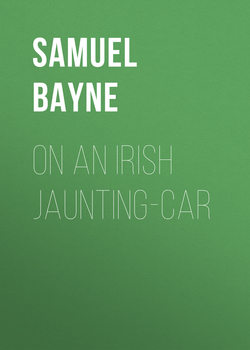On an Irish Jaunting-car

Реклама. ООО «ЛитРес», ИНН: 7719571260.
Оглавление
Bayne Samuel Gamble. On an Irish Jaunting-car
NEW YORK TO LONDONDERRY
LONDONDERRY TO PORT SALON
PORT SALON TO DUNFANAGHY
DUNFANAGHY TO FALLCARRAGH
FALLCARRAGH TO GWEEDORE
GWEEDORE TO GLENTIES
GLENTIES TO CARRICK
CARRICK TO DONEGAL
DONEGAL TO BALLYSHANNON
BALLYSHANNON TO SLIGO
SLIGO TO BALLINROBE
BALLINROBE TO LEENANE
LEENANE TO RECESS
ACHILL ISLAND
RECESS TO GALWAY
ARAN ISLANDS
LIMERICK
CORK AND QUEENSTOWN
Отрывок из книги
As our destination was Londonderry, we took a northerly course, which brought us into floating ice-fields and among schools of porpoises and whales; in fact, it was an uneventful day on which some passenger could not boast of having seen "a spouter, just a few minutes ago!"
We celebrated the morning of the Fourth of July in a very pretentious way with a procession of the nations in costume and burlesques on the conditions of the day. The writer was cast to represent the Beef Trust, and at two hundred and twenty-five pounds the selection met with popular approval; but he found a passenger of thirty-five pounds more in the foreground, and thereupon retired to the side-lines. Attorney Grant, of New York, made a striking "Rob Roy," with his colossal Corinthian pillars in their natural condition. A long list of games and a variety of races for prizes gave us a lively afternoon, and the evening wound up with a "grand" concert, at which Professor Green, of Yale, made an excellent comic oration.
.....
We are now in "Derry," as it is called in Ireland, and every man in it is "town proud"; and well he may be, as Derry has a historical record second to but few cities in any country, and its siege is perhaps the most celebrated in history. At this writing it has a population of thirty-three thousand and is otherwise prosperous. Saint Columba started it in 546 A.D. by building his abbey. Then came the deadly Dane invader, swooping down on this and other Foyle settlements and glutting his savage appetite for plunder. Out of the ruins left by the Danes arose in 1164 the "Great Abbey of Abbot O'Brolchain," who was at that time made the first bishop of Derry. The English struggled and fought for centuries to gain a foothold in this part of Ireland, but to no purpose until Sir Henry Docrora landed, about 1600 A.D., on the banks of the Foyle with a force of four thousand men and two hundred horse. He restored Fort Culmore and took Derry, destroyed all the churches, the stones of which he used for building fortifications, and left standing only the tower of the cathedral, which remained until after the siege.
In 1608 Sir Cahir O'Doherty, of Inishowen, who at first had favored the settlement, rebelled, took Culmore fort, and burned Derry. His death, and the "flight of the earls" Tyrone and Tyrconnell to France, left Derry and other vast possessions to English confiscation, over two hundred thousand acres alone falling to the citizens of London. The walls were built in 1609, and still remain in good condition, being used as a promenade; the original guns bristle from loop-holes at intervals, and "Roaring Meg" will always have a place in history for the loud crack she made when fired on the enemy. She sits at the base of Walker's monument now, silent, but still ugly. This monument is erected on a column ninety feet high, starting from a bastion on the wall, and has a statue of Walker on its summit. One of the earliest feats in sight-seeing which the writer ever accomplished was to climb to its top, up a narrow flight of spiral stairs. (There would not be room enough for him in it now.)
.....